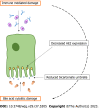Sequence of events leading to primary biliary cholangitis
- PMID: 37899786
- PMCID: PMC10600805
- DOI: 10.3748/wjg.v29.i37.5305
Sequence of events leading to primary biliary cholangitis
Abstract
Primary biliary cholangitis (PBC) is a chronic cholestatic liver disease that is observed more frequently in middle-aged women. This disorder is considered an autoimmune disease, since liver injury is sustained by the presence of self-directed antimitochondrial antibodies targeting the bile duct cells. The prognosis may vary depending on an early diagnosis and response to therapy. However, nearly a third of patients can progress to liver cirrhosis, thus requiring a liver transplant. Traditional immunosuppressive therapies, commonly employed for other autoimmune diseases, have limited effects on PBC. In fact, dramatic functional changes that occur in the biliary epithelium in the course of inflammation play a major role in perpetuating the injury. In this minireview, after a background on the disease and possible predisposing factors, the sequential cooperation of cellular/molecular events leading to end-stage PBC is discussed in detail. The rise and maintenance of the autoimmune process, as well as the response of the biliary epithelia during inflammatory injury, are key factors in the progression of the disease. The so-called "ductular reaction (DR)", intended as a reactive expansion of cells with biliary phenotype, is a process frequently observed in PBC and partially understood. However, recent findings suggest a strict relationship between this pathological picture and the progression to liver fibrosis, cell senescence, and loss of biliary ducts. All these issues (onset of chronic inflammation, changes in secretive and proliferative biliary functions, DR, and its relationship with other pathological events) are discussed in this manuscript in an attempt to provide a snapshot, for clinicians and researchers, of the most relevant and sequential contributors to the progression of this human cholestatic disease. We believe that interpreting this disorder as a multistep process may help identify possible therapeutic targets to prevent evolution to severe disease.
Keywords: Antimitochondrial antibody; Biliary proliferation; Biliary secretion; Cellular senescence; Cholangiocyte; Ductular reaction; Liver fibrosis; Primary biliary cholangitis.
©The Author(s) 2023. Published by Baishideng Publishing Group Inc. All rights reserved.
Conflict of interest statement
Conflict-of-interest statement: There is no conflict of interest associated with any of the senior author or other coauthors contributed their efforts in this manuscript.
Figures


Similar articles
-
Expression of bcl-2 in ductular proliferation is related to periportal hepatic stellate cell activation and fibrosis progression in patients with autoimmune cholestasis.Dig Liver Dis. 2007 Mar;39(3):262-6. doi: 10.1016/j.dld.2006.12.004. Epub 2007 Jan 30. Dig Liver Dis. 2007. PMID: 17270507
-
Immunohistochemical differences in the portal tract and acinar infiltrates between primary biliary cirrhosis and autoimmune cholangitis.Eur J Gastroenterol Hepatol. 2002 Oct;14(10):1143-50. doi: 10.1097/00042737-200210000-00016. Eur J Gastroenterol Hepatol. 2002. PMID: 12362106
-
[Primary biliary cholangitis].Rev Prat. 2021 Oct;71(8):885-891. Rev Prat. 2021. PMID: 35147347 French.
-
[Autoimmune liver diseases and their overlap syndromes].Praxis (Bern 1994). 2006 Sep 6;95(36):1363-81. doi: 10.1024/1661-8157.95.36.1363. Praxis (Bern 1994). 2006. PMID: 16989180 Review. German.
-
[Cholestatic liver diseases].Ther Umsch. 2004 Aug;61(8):521-7. doi: 10.1024/0040-5930.61.8.521. Ther Umsch. 2004. PMID: 15457969 Review. German.
Cited by
-
Editor-in-Chief articles of choice and comments at the year-end of 2023.World J Gastroenterol. 2024 Jan 7;30(1):1-8. doi: 10.3748/wjg.v30.i1.1. World J Gastroenterol. 2024. PMID: 38293322 Free PMC article.
-
Development of Autoimmune Hepatitis after COVID-19 Infection in Vaccinated Women.Rev Recent Clin Trials. 2024;19(4):267-272. doi: 10.2174/0115748871292641240514114921. Rev Recent Clin Trials. 2024. PMID: 38797899
References
-
- Heathcote EJ. Primary biliary cirrhosis: historical perspective. Clin Liver Dis. 2003;7:735–740. - PubMed
-
- Sherlock S. Primary billiary cirrhosis (chronic intrahepatic obstructive jaundice) Gastroenterology. 1959;37:574–586. - PubMed
-
- Younossi ZM, Bernstein D, Shiffman ML, Kwo P, Kim WR, Kowdley KV, Jacobson IM. Diagnosis and Management of Primary Biliary Cholangitis. Am J Gastroenterol. 2019;114:48–63. - PubMed
Publication types
MeSH terms
LinkOut - more resources
Full Text Sources
Medical

